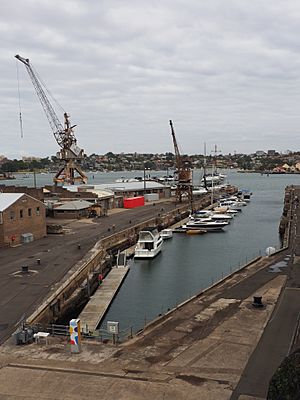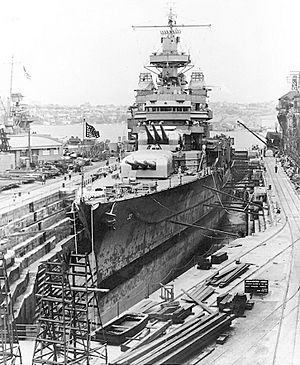Sutherland Dock facts for kids
Quick facts for kids Sutherland Dock |
|
|---|---|

Sutherland Dock
|
|
| Location | Cockatoo Island, New South Wales, Australia |
| Official name: Sutherland Dock | |
| Type | Listed place (Historic) |
| Designated | 22 June 2004 |
| Reference no. | 105260 |
| Lua error in Module:Location_map at line 420: attempt to index field 'wikibase' (a nil value). | |
Sutherland Dock is a very old and important dry dock located on Cockatoo Island in Sydney Harbour, Australia. A dry dock is like a giant bathtub for ships, where the water can be drained out so people can work on the ship's bottom. This dock was built a long time ago, in 1890, and was once one of the biggest in the world! It helped repair and build many ships, especially for the Royal Australian Navy during important times like World War I and World War II. Today, it is recognized as a special heritage site.
Contents
The Story of Cockatoo Island and the Dock
From Prison to Shipyard: Early Days
Cockatoo Island started as a prison in 1839. Convicts were sent there to work, and one of their big jobs was quarrying stone. Later, in 1857, the Fitzroy Dock was finished. This made Cockatoo Island a major place for building and fixing government ships in Australia.
In 1869, the prisoners left the island. The prison buildings then became a school for girls and a reformatory until 1888. After that, prisoners returned for a while. But the dockyard part of the island kept growing. The New South Wales Public Works Department officially made Cockatoo Island the state's main dockyard.
After Australia became a federation of states in 1901, Cockatoo Island became the Commonwealth Dockyard in 1913. This meant it was now run by the Australian Government. The island played a huge role in building the Royal Australian Navy. It was also very important during World War I, helping to build and service ships for the war effort.
From 1933, a company called Cockatoo Docks and Engineering Co Ltd leased the dockyard. The island became even more vital during World War II, repairing many ships. After the war, the dockyard continued to operate, even adding facilities for submarines. However, the dockyard eventually closed in 1992. Today, the island is managed by the Sydney Harbour Federation Trust.
Building the Sutherland Dock
Why a New Dock Was Needed
As the 1800s went on, ships became much bigger, especially with the use of steel. The older Fitzroy Dock was becoming too small for these larger vessels. So, the decision was made to build a new, bigger dry dock on Cockatoo Island.
Work on the new dock began in 1882. It involved digging a huge hole into the sandstone of the island. The Sutherland Dock was designed by a young engineer named Louis Samuel, who was only 23 years old when he won the contract. Sadly, he died at 26, before the dock was fully finished. His younger brother, Edward, completed the project. Unlike Fitzroy Dock, which was built by convicts, the workers on Sutherland Dock were free laborers.
A World-Class Engineering Project
When Sutherland Dock was finished in 1890, it was 635 feet (about 194 meters) long and 84 feet (about 25 meters) wide at its entrance. At the time, it was considered the biggest dry dock in the world because of its width and how deep the water was over its entrance. It was one of Australia's most impressive engineering projects of that time.
The dock was later made even bigger twice to fit larger Australian naval ships. By 1927, it reached 690 feet (210 meters) in length and 27 meters in width. The dock was named after John Sutherland, who was a government minister. It cost a lot of money to build.
A special part of the dock's design was its "gate," called a caisson. This was a very heavy iron structure that moved horizontally on bronze rollers, pulled by a chain. It was first powered by steam and later by electricity in 1918. The dock also had electric lights, which was very modern for the time, allowing work to continue at night if needed. A new pump house was built to help drain water from both Sutherland and Fitzroy Docks.
Sutherland Dock was built to handle the biggest ships of the Royal Navy. After the Royal Australian Navy was formed, it served their largest vessels, like battle cruisers and other big ships. These ships would come to Sutherland Dock twice a year for routine cleaning, painting, and repairs.
Later, a bigger dock called the Captain Cook Graving Dock was completed in 1945 at Garden Island. This meant some of the work for very large ships moved there. However, Sutherland Dock still took big ships, including HMAS Melbourne after its collisions with other ships. Many non-navy ships, like merchant vessels and passenger ships, also used Sutherland Dock for repairs.
What Sutherland Dock Looks Like
Sutherland Dock is a "dry dock" or "graving dock." It's dug right into the sandstone on the south-western side of Cockatoo Island in Sydney Harbour. The dock is 210 meters long, and the water depth over its entrance can be up to 9.75 meters at high tide. The special chain and machinery that move the caisson (the dock's gate) are still there. You can also see old steam-powered cranes near the dock.
The dock is a very noticeable part of Cockatoo Island. It strongly reminds people of the island's history with ships and the sea, making it a very interesting and important place to see.
Why Sutherland Dock is Important
Sutherland Dock was added to the Australian Commonwealth Heritage List in 2004 because it is a very special place for several reasons:
- History: It has a long and direct connection to Australia's maritime history and its naval development, especially during World War I and World War II. It is one of Australia's most important former dry docks.
- Development: The fact that the dock was made bigger over time shows how warship building and shipbuilding in general changed during the early 1900s.
- Design: It is a great example of a large harbor facility from the 1800s.
- Appearance: Sutherland Dock is a major part of Cockatoo Island's landscape. It helps create the island's unique atmosphere related to the sea and ships, making it very interesting to look at.
- Engineering: When it opened, Sutherland Dock was said to be the biggest dry dock in the world. It was one of Australia's greatest engineering projects and remained the country's largest dry dock until 1945. This shows its significant technological importance and good design. The original caisson and its unique moving system are still there today.


